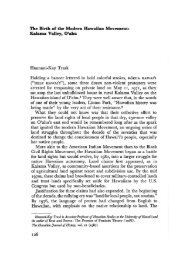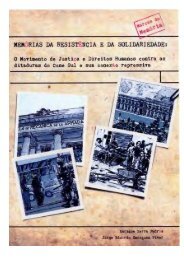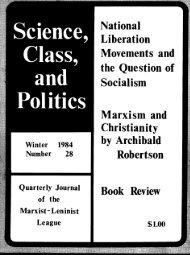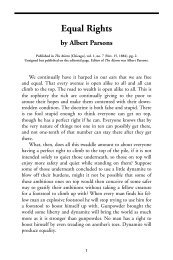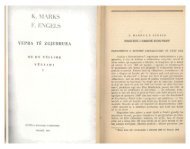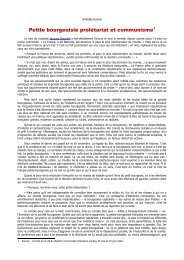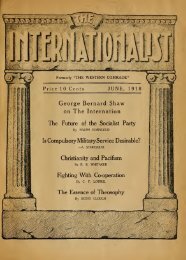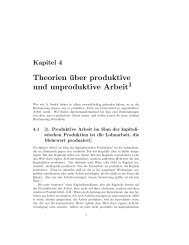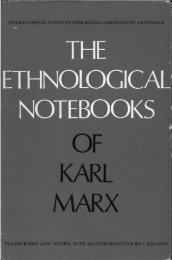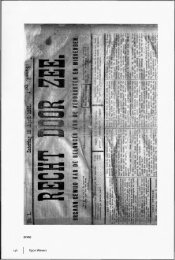Labor Defender June 1927 Volume 2, No. 6 - Marxists Internet Archive
Labor Defender June 1927 Volume 2, No. 6 - Marxists Internet Archive
Labor Defender June 1927 Volume 2, No. 6 - Marxists Internet Archive
Create successful ePaper yourself
Turn your PDF publications into a flip-book with our unique Google optimized e-Paper software.
can McDonald, Forest Bailey, Ellen<br />
Hayes.<br />
Among other cables sent were those<br />
from organizations in New York, Chicago,<br />
Perth Amboy, N. J.; Detroit,<br />
Mich., and others.<br />
American <strong>Labor</strong>, together with workers<br />
everywhere, must continue to protest<br />
on behalf of the persecuted Hungarian<br />
wonker and to expose the farcical<br />
trials accorded radical workers.<br />
The Rakosi-Vagi trial of 1926 was a<br />
sample of the methods of terror of the<br />
Horthy domination and the trial of<br />
Szanto and his 30 "accomplices" is but<br />
a continuation of the attempts of reactionary<br />
Hungary to destroy the labor<br />
movement. This must be resisted<br />
on an international scale.<br />
The exit of one of the three, however,<br />
was quick. Adamchesky was released<br />
on bail within a day or two. But Rubeustein<br />
is still in, and Sheriff Ximino<br />
still struts supreme.<br />
What is this charge for which Jack<br />
Rubenstein received six months in the<br />
county jail and was fined $500? The<br />
case started more than a year ago, ou<br />
March, 1920, when Jack Rubenstein led<br />
a picket line of 800 strikers to the National<br />
Silk Dyeing plant in East Paterson,<br />
and was sentenced later to 90 days<br />
on the personal charge of Sheriff Nimmo.<br />
March 19 he was released on bail<br />
pending the appeal of this case, but<br />
was rearrested immediately afterward<br />
on a charge of assault and battery<br />
made by one of the jail keepers. Hubert<br />
LeFevre. The keeper claimed that Rubenstein<br />
assaulted him when he tried<br />
to stop an argument between Rubenstein<br />
and another prisoner. After this<br />
alleged assault, Rubenstein was kept in<br />
solitary confinement until called to<br />
court.<br />
What really happened, as Rubenstein,<br />
himself, tells it was this: During<br />
certain hours of the day the doors of<br />
the cells arc left open. Rubenstein<br />
was taking a nap on the cot in his<br />
cell with the door open, when lie was<br />
awakened by an awful rumpus in the<br />
cell next to his, occupied by two prisoners<br />
not strikers. Rubenstein got<br />
up and walked to the door of this cell<br />
where two men were quarreling. Just<br />
then the keeper ran up the stairs and<br />
with no explanation began cursing and<br />
striking Rubenstein who raised his<br />
arms to protect his face and head from<br />
the blows. In some such way as this,<br />
arise most of the charges against strikers<br />
of "assaulting the police."<br />
On March 22, 1926, Rubenstein was<br />
released again on $3,500 bail pending<br />
the trial. In May he had a trial by<br />
jury. It was at the height of the strike<br />
when prejudice against strikers was intense.<br />
The jury apparently felt that<br />
to be good citizens they should bring<br />
in a verdict of guilty. However, the<br />
evidence of the prosecution was flimsy<br />
and Rubenstein's account sounded convincing<br />
so they tried to compromise.<br />
Joseph Feder, the attorney, who<br />
handled the case for the defense tells<br />
how the jury returned and asked the<br />
judge if they could not bring in a ver-<br />
(Continued on page 95.)<br />
THE LABOR DEFENDER 85<br />
Jack Rubenstein and 'Whitey' Adamchesky<br />
HEEE were two young men who<br />
T used to meet many times during<br />
the months of the Passaic Textile<br />
Strike, on opposite sides of the battleline.<br />
The coal-black head of one was<br />
seen continually at the head of picket<br />
lines in front of the gates of the various<br />
mills. The yellow-white hair of the<br />
other was known as a danger signal<br />
to thousands of strikers.<br />
"Whitey" Adamchesky probably had<br />
the distinction of having arrested more<br />
strikers during the struggle than any<br />
other cop. And Jack Rubenstein was<br />
certainly arrested oftener. Next to Albert<br />
Weisbord and possibly Sheriff<br />
Mmino, these two, the tall, slim Rubenstein<br />
and the short, stocky Stephen<br />
Adamches'ky tearing around madly on<br />
his motorcycle arresting strikers, were<br />
perhaps the best known characters of<br />
the strike.<br />
And so it was that two bits of news<br />
which by a strange coincidence came<br />
almost at the same time created more<br />
excited comment among the former<br />
strikers than any other news since the<br />
strike was settled. Jack Rubenstein<br />
and "Whitey" Adamchesky who had<br />
met so often on the battle line were destined<br />
to meet again long after the<br />
By Hollace Ransdell<br />
jail, presided over by the famous little<br />
Sheriff Nimmo, held these two renowned<br />
strike figures. The strike may be<br />
over but the drama still goes on.<br />
Adamchesky is reported by the police<br />
to have made a confession of his crime.<br />
Another ironic touch appreciated by<br />
Jack Rubenstein.<br />
those who are familiar with the third<br />
degree confessions which Adamchesky<br />
used to help torture out of strikers.<br />
This confession was obtained in the<br />
same police court about which the<br />
A clash in Passaic. "Whitey" is the cop in the center with hack turned.<br />
strike was over—in jail. And on the<br />
same side of the bars this time.<br />
On April 28, <strong>1927</strong>, Rubenstein was<br />
sentenced to six months in the county<br />
jail and fined $500, on a strike charge<br />
which originated more than a year ago.<br />
A day or two later "Whitey" was arrested,<br />
charged with robbing a garage.<br />
For a brief time the Bergen County<br />
strikers tell such gloomy stories.<br />
With the jail aa the setting then,<br />
these three interesting characters enter<br />
the scene—the dark, gentle young<br />
Jewish idealist, the white-lashed, brutal,<br />
twisted-minded police officer and<br />
the scrawny, noisy despotic little Sheriff<br />
whose hatred of strikers has become<br />
almost a madness.



